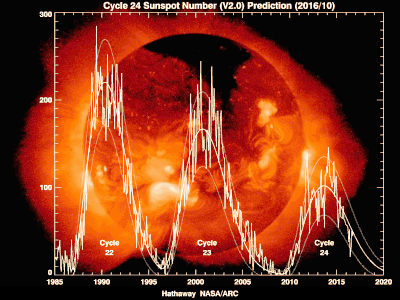Unsolved Mystery Of Astronomy
- Galaxy Rotation Problem
- Supermassive Black Hole
- Dark Energy
- Mystery Of Solar Cycle
- Galaxy Rotation Problem
 The galaxy rotation problem is the difference between observed galaxy rotation curves and the theoretical prediction, assuming a centrally controlled mass associated with the observed luminous material. When mass forms of galaxies are calculated from the distribution of stars in spirals and mass-to-light ratios in the stellar disks, they do not match with the masses received from the observed rotation curves and the law of gravity. A solution to this problem is to hypothesize the presence of dark matter and to understand its distribution from the galaxy's centre out to its aurora.
The galaxy rotation problem is the difference between observed galaxy rotation curves and the theoretical prediction, assuming a centrally controlled mass associated with the observed luminous material. When mass forms of galaxies are calculated from the distribution of stars in spirals and mass-to-light ratios in the stellar disks, they do not match with the masses received from the observed rotation curves and the law of gravity. A solution to this problem is to hypothesize the presence of dark matter and to understand its distribution from the galaxy's centre out to its aurora.  Is dark matter responsible for differences in observed and theoretical speed of stars revolving around the centre of galaxies, or is it something else? Though dark matter is by far the most accepted explanation of the rotation problem, other proposals have been offered with varying degrees of success. Of the possible alternatives, one of the most notable is modified Newtonian dynamics (MOND), which involves modifying the laws of gravity.
Is dark matter responsible for differences in observed and theoretical speed of stars revolving around the centre of galaxies, or is it something else? Though dark matter is by far the most accepted explanation of the rotation problem, other proposals have been offered with varying degrees of success. Of the possible alternatives, one of the most notable is modified Newtonian dynamics (MOND), which involves modifying the laws of gravity.
- Supermassive Black Hole
Supermassive black holes are the largest type of black hole. They contain a mass of the order of hundreds of thousands to billions of times the mass of the Sun.

M–σ relation suggests that some kind of feedback acts to maintain the connection between black hole mass and stellar velocity dispersion, in spite of processes like galaxy mergers and gas accretion that might be expected to increase the scatter over time. But scientist still researching the origin of the M-sigma relation between supermassive black hole mass and galaxy velocity dispersion?
Supermassive black holes are the largest type of black hole. They contain a mass of the order of hundreds of thousands to billions of times the mass of the Sun.

M–σ relation suggests that some kind of feedback acts to maintain the connection between black hole mass and stellar velocity dispersion, in spite of processes like galaxy mergers and gas accretion that might be expected to increase the scatter over time. But scientist still researching the origin of the M-sigma relation between supermassive black hole mass and galaxy velocity dispersion?
This is the first direct image taken of a supermassive black hole, located at the galactic core of Messier 87. It shows a heated accretion ring orbiting the object at a mean separation of 350 AU or ten times larger than the orbit of Neptune around the Sun. The dark centre is the event horizon and its shadow.
(CREDITS NASA)
Dark energy is a word that represents an unexplored form of energy that transforms the universe on the biggest scales. The first observational data for its existence came from supernovae measurements, which revealed that the universe does not expand at a steady speed; rather, the expansion of the universe is accelerating
 Previous to these observations, the only data of matter-energy recognised existing that ordinary matter, dark matter, and radiation. Measurements of the cosmic microwave background suggest the universe originated in a hot Big Bang, from which general relativity explains its development and the following large scale motion Without introducing a new form of energy. Thus scientist still did not What is the cause of the observed accelerated expansion of the universe?
Previous to these observations, the only data of matter-energy recognised existing that ordinary matter, dark matter, and radiation. Measurements of the cosmic microwave background suggest the universe originated in a hot Big Bang, from which general relativity explains its development and the following large scale motion Without introducing a new form of energy. Thus scientist still did not What is the cause of the observed accelerated expansion of the universe? - Mystery Of Solar Cycle
The First Question arrives is what is the solar cycle? The solar cycle or solar magnetic activity cycle is a nearly periodic 11-year change in the Sun's activity. Generally speaking, with each cycle, the Sun's north and south poles trade places. Levels of solar radiation and ejection of solar material, the number and size of sunspots, solar flares, and coronal loops all exhibit a synchronized fluctuation, from active to quiet to active again, with a period of 11 years. This cycle has been observed for centuries by changes in the Sun's appearance and by terrestrial phenomena such as auroras.


(Rights and Credits goes to NASA)
The changes on the Sun cause effects in space, in the Earth's atmosphere, and on Earth's surface. While the cycle is the dominant influence on solar activity, aperiodic fluctuations also occur.
But Scientist still don't know that How does the Sun generate its periodically reversing large-scale magnetic field? How do other solar-like stars generate their magnetic fields, and what are the similarities and differences between stellar activity cycles and that of the Sun?. The scientist is still researching it.




0 Comments